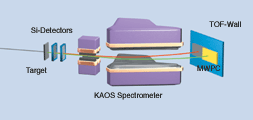Experimental Results
Coulomb Dissociation of 8B at 254 A MeV

Schematic view of the experimental set-up at the KAOS spectrometer. The B8 beam enters from the left and hits the Pb208 break-up target. The outgoing protons and Be7 fragments are detected in two pairs of position-sensitive silicon detectors before, and in two multiwire-proportional chambers after the detector. The TOF-wall serves as a trigger detector. The non-interacting B8 projectiles hit only the right-hand part of the TOF wall.
Coulomb dissociation has been suggested as an alternative tool to measure the cross sections (or, equivalently, the astrophysical S-factor) of radiative-capture reactions. We have applied this method to the 7Be(p,gamma)8B reaction which is of great relevance in connection with the so-called solar-neutrino problem. We have bombarded a 208Pb target with a 254 A MeV secondary 8B beam from the FRS and identified the breakup products, p and 7Be, in coincidence at the Kaon spectrometer KaoS which also measured their momenta with good resolution and high efficiency. The results have been published as an article [1] in Physical Review Letters 83, 2910 (1999).
 The figure shows the final results in terms of the E1 astrophysical
S-factor (red circles) in comparison with other Coulomb-dissociation
(green) and direct proton-capture (blue) experiments.
Theoretical calculations are also shown for the single-particle model
of Bertulani ([2], red line) and the cluster-model
of Descouvement et al. [3], blue line]),
each of them normalized to match our and the direct proton-capture
data, respectively.
The figure shows the final results in terms of the E1 astrophysical
S-factor (red circles) in comparison with other Coulomb-dissociation
(green) and direct proton-capture (blue) experiments.
Theoretical calculations are also shown for the single-particle model
of Bertulani ([2], red line) and the cluster-model
of Descouvement et al. [3], blue line]),
each of them normalized to match our and the direct proton-capture
data, respectively.
From our two data points below 0.45 MeV, a zero-energy S-factor S17(0)=20.6 eV b has been deduced, with a statistical error of 1.2 eV b, and an estimated extrapolation error of 1.0 eV b. This is close to the results from the most recent low-energy direct proton-capture experiment [4] and from indirect determinations via the asymptotic normalization coefficients [5].
Contact person
Klaus Sümmerer
(Gesellschaft für Schwerionenforschung,
D-64220 Darmstadt, Germany)
[1] N. Iwasa et al. et al., Phys. Rev. Lett. 83, 2910 (1999).
[2] C.A. Bertulani, Z. Physik A 356, 293 (1996).
[3] P. Descouvement and D. Baye, Nucl. Phys. A567, 341 (1994).
[4] F. Hammache et al., Phys. Rev. Lett. 80, 928 (1998).
[5] A. Azhari et al., Phys. Rev. C 60, 055803 (1999).
More links about this experiment:
GSI-Nachrichten (English)
Pictures of the 8B Beamtime in March 2000